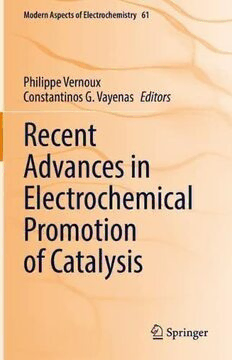
Recent Advances in Electrochemical Promotion of Catalysis (Modern Aspects of Electrochemistry, 61) PDF
Preview Recent Advances in Electrochemical Promotion of Catalysis (Modern Aspects of Electrochemistry, 61)
Modern Aspects of Electrochemistry Volume 61 SeriesEditors Constantinos G. Vayenas, Department of Chemical Engineering, University of Patras,Patras,Greece RalphE.White,DepartmentofChemicalEngineering,UniversityofSouth Carolina,Columbia,SC,USA Thiswell-respectedseriescommencedpublicationintheearly1950s.Overtheyears it has earned an excellent reputation by offering high quality reviews of current researchintoallareasofelectrochemistryandelectrochemicalengineeringandtheir applications.TheinternationalmagazineChemistry&Industrynotesthatthisseries “deserves a place in electrochemistry libraries and should prove useful to electrochemists and related workers.” Starting with Number 43 in the series, two featureshavebeenintroduced: (cid:129) Each volume is thematic and focuses on a new development in the field or reviewsawell-establishedareathatisregaininginterest. (cid:129) Eachvolumeisguest-edited.Asinthepast,allchaptersaretopicalreviews. Subjectscoveredinrecentvolumesinclude: 1. ModelingandNumericalSimulations 2. ProgressinCorrosionScienceandEngineering 3. Electrodeposition:TheoryandPractice 4. Electrocatalysis:TheoryandExperiments 5. InterfacialPhenomenainFuelCellElectrocatalysis 6. DiagnosticsandModelingofPolymerElectrolyteFuelCells 7. ApplicationsofElectrochemistryandNanotechnologyinBiologyandMedicine (cid:129) Philippe Vernoux Constantinos G. Vayenas Editors Recent Advances in Electrochemical Promotion of Catalysis Editors PhilippeVernoux ConstantinosG.Vayenas UniversitédeLyon DepartmentofChemicalEngineering InstitutdeRecherchessurlaCatalyseet UniversityofPatras l’EnvironnementdeLyon,UMR5256, Patras,Greece CNRS,UniversitéClaudeBernardLyon1 Villeurbanne,France ISSN0076-9924 ISSN2197-7941 (electronic) ModernAspectsofElectrochemistry ISBN978-3-031-13892-8 ISBN978-3-031-13893-5 (eBook) https://doi.org/10.1007/978-3-031-13893-5 ©TheEditor(s)(ifapplicable)andTheAuthor(s),underexclusivelicensetoSpringerNatureSwitzerland AG2023 Thisworkissubjecttocopyright.AllrightsaresolelyandexclusivelylicensedbythePublisher,whether thewholeorpartofthematerialisconcerned,specificallytherightsoftranslation,reprinting,reuseof illustrations, recitation, broadcasting, reproduction on microfilms or in any other physical way, and transmission or information storage and retrieval, electronic adaptation, computer software, or by similarordissimilarmethodologynowknownorhereafterdeveloped. Theuseofgeneraldescriptivenames,registerednames,trademarks,servicemarks,etc.inthispublication doesnotimply,evenintheabsenceofaspecificstatement,thatsuchnamesareexemptfromtherelevant protectivelawsandregulationsandthereforefreeforgeneraluse. The publisher, the authors, and the editorsare safeto assume that the adviceand informationin this bookarebelievedtobetrueandaccurateatthedateofpublication.Neitherthepublishernortheauthorsor theeditorsgiveawarranty,expressedorimplied,withrespecttothematerialcontainedhereinorforany errorsoromissionsthatmayhavebeenmade.Thepublisherremainsneutralwithregardtojurisdictional claimsinpublishedmapsandinstitutionalaffiliations. ThisSpringerimprintispublishedbytheregisteredcompanySpringerNatureSwitzerlandAG Theregisteredcompanyaddressis:Gewerbestrasse11,6330Cham,Switzerland To our parents, our wives Susanne and Valérie, and our children Anne, George- Philippe, Lucie, Paul, and Thibault. Preface Twenty years have passed since the book entitled Electrochemical Activation of Catalysis:Promotion,ElectrochemicalPromotionandMetal-SupportInteractions, authorizedbyC.G.Vayenas,S.Bebelis,C.Pliangos,S.Brosda,andD.Tsiplakides, and prologized in the foreword by the famous Professor John O’ M. Bockris, was publishedbyKluwerAcademic/PlenumPublishers. That book established the basic phenomenology of the electrochemical promo- tion of catalysis (EPOC) by reviewing more than 70 catalytic reactions which had been already electropromoted atthetime.The rules ofelectrochemical,but also of chemical, promotion were also derived and discussed, and it was established that promotion, electrochemical promotion, and metal-support interactions are funda- mentallyequivalentandonlyoperationallydifferent. Thepresentvolumereviewsthescientificadvancesofthelasttwodecadesinthe EPOCfield,startingfromitsstory,thequestforitsunderstanding,andefforttowards practicalapplications.AmajorpracticalapplicationstemmingfromtheopenEPOC literature has been in the correct choice of supports and promoters to optimize practical catalyst performance. The extent of this informational spillover is hard to quantify,butwehavelearnedfromverygoodcolleaguesandfriendsintheNAEof the USA and from industrial partners that catalyst manufacturers, for example, for ethylene epoxidation and emission control catalysts, were following for years with great interest the open EPOC literature on this reaction and were making their, at least initial, promoter screening and selection by using this literature as a valuable guideline.SomeoftheseaspectsarediscussedinChap.2ofthepresentbookbyone of the world’s top EPOC experts on ethylene epoxidation, Professor Symeon Bebelis. Professor Elena Baranova at Ottawa University, along with her co-workers Arash Fellah Jahromi and Christopher Panaritis, has exhaustively reviewedtheintensiveresearchefforttotailorelectro-promotedmetalnanoparticles (Chap.3).Thischapterhighlightsthevarietyofmethodsusedtopreparemono-and bimetallic- nanoparticles and promising results recently obtained on transition metals.Themechanismandpotentialapplicationsoftheself-sustainedelectrochem- icalpromotionconceptarealsofullydiscussed.Inthecourseofthisphenomenon,a vii viii Preface major discovery was made by Professor Ioannis Yentekakis at the Technical Uni- versityofCreteatChania.Hefoundthatthespontaneouslyformedeffective-double layer([Oδ(cid:1),δ+])onthecatalystparticles,resultingfromthethermallydrivenoxygen back-spillover from high OSC (oxygen storage capacity) supports, can strongly increase the thermal resistance of metallic nanoparticles (Chap. 4). This is a very important theoretical and practical finding which will be almost certainly fully utilizedbythecatalystmanufacturingindustry. The use of EPOC to face very important environmental challenges is described subsequently by the second chapter of Professor Ioannis Yentekakis (Chap. 5), coauthored with Professors Philippe Vernoux and Angel Caravaca, for emission controlcatalysts, and also in Chap. 6, co-authored by ChristosChatzilias, Eftychia Martino, Dimitrios Zagoraios, Professors Kyriakou and Katsaounis on the electropromotionofCO valorizationcatalysts. 2 Two important applications of EPOC related to H production and to ammonia 2 synthesis are discussed in the chapters by Doctor Ruiz-Lopez, Profes- sor Fernando Dorado, and Professor Antonio de Lucas-Consuegra (H production, 2 Chap.7)andAnastasiosVouros,IoannisGaragounis,andProfessorStoukides(NH 3 synthesis,Chap.8). In the last chapter of the book, Professors Angel Caravaca, Jesus Gonzalez- Cobos, Vasilis Kyriakou, and Philippe Vernoux provide a thorough and realistic in-depthdiscussionontheprospectstowardslarge-scaleapplicationofEPOC. Patras,Greece ConstantinosG.Vayenas Villeurbanne,France PhilippeVernoux Contents PartI EPOC:StoryandFundamentals 1 Presentation,Story,andMechanisticUnderstanding ofElectrochemicalPromotionofCatalysis. . . . . . . . . . . . . . . . . . . . 3 ConstantinosG.VayenasandPhilippeVernoux 2 ElectrochemicalPromotionofCatalysis:FromDiscovery toFundamentalstoApplications. . . . . . . . . . . . . . . . . . . . . . . . . . . . 21 SymeonBebelis PartII EPOCinNano-DispersedCatalysts 3 TheQuestofElectropromotedNano-dispersedCatalysts. . . . . . . . . 69 ArashFellahJahromi,ChristopherPanaritis,andElenaA.Baranova 4 TheEffective-Double-LayerasanEfficientToolfortheDesign ofSinter-ResistantCatalysts. . . . . . . . . . . . . . . . . . . . . . . . . . . . . . . 117 IoannisV.Yentekakis PartIII EPOCtoFaceEnvironmentalChallenges 5 EPOCwithAlkalineConductors:Implementations inEmissionControlCatalysis. . . . . . . . . . . . . . . . . . . . . . . . . . . . . . 153 IoannisV.Yentekakis,PhilippeVernoux,andAngelCaravaca 6 ElectrochemicalPromotionofCatalysisforCO Valorization. . . . . . 219 2 ChristosChatzilias,EftychiaMartino,DimitriosZagoraios, GeorgiosKyriakou,andAlexandrosKatsaounis ix x Contents PartIV EPOCtoAcceleratetheEnergyTransition 7 RecentStudiesofElectrochemicalPromotionforH Production 2 fromEthanol. .. . . . . .. . . . . . .. . . . . . .. . . . . .. . . . . . .. . . . . . .. 269 EstelaRuiz-López,FernandoDorado,andAntoniodeLucas-Consuegra 8 ElectrochemicalPromotionandRelatedPhenomena DuringAmmoniaSynthesis. . . . . . . . . . . . . . . . . . . . . . . . . . . . . . . . 303 AnastasiosVourros,IoannisGaragounis,andMichaelStoukides PartV ProspectsTowardstheApplication 9 ChallengesforApplicationsoftheElectrochemical PromotionofCatalysis. . . . . . . . . . . . . . . . . . . . . . . . . . . . . . . . . . . 335 J.González-Cobos,A.Caravaca,V.Kyriakou,andP.Vernoux Index. . . . . . . . . . . . . . . . . . . . . . . . . . . . . . . . . . . . . . . . . . . . . . . . . . . 379
